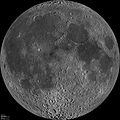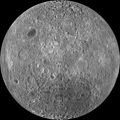- Planetary Observer program
-
The Planetary Observer program is a cancelled space exploration program designed by NASA to provide cheaper planetary orbiters by utilising Earth-orbiting satellite components and technology, using solar panels for power, and a common spacecraft bus platform for all Planetary Observer-class probes. Only one spacecraft of this class was eventually constructed Mars Observer.[1][2]
Contents
History
After the flagship multi-billion dollar missions of the 1970s, in the 1980s NASA was looking for a new, more affordable direction for the 1990s and beyond. Two projects were conceived by NASA's Solar System Exploration Committee in 1983, the Planetary Observer program and Mariner Mark II. The Observer program, starting with Mars Observer, was envisioned as a series of low-cost missions to the inner solar system, based on commercial Earth satellites. The Mariner Mark II, on the other hand, was to be a series of large spacecraft for the exploration of the outer solar system.[3]
The first Planetary Observer spacecraft to be approved was Mars Observer, in 1985.[4] Lunar Observer (LO), proposed for a 1997 launch,[5] would have been sent into a long-term lunar orbit at 60 miles above the moon's poles. The Mercury Observer (MO) was also proposed for a 1997 launch. However, Congressionally imposed reductions to FY 1992-93 funding requirements forced NASA to terminate the Planetary Observer program, with just Mars Observer funded.
Mars Observer
Main article: Mars ObserverMars Observer was an unmanned spacecraft designed to study the geoscience and climate of Mars. The first of the proposed Observer series of planetary missions, it was launched by NASA on September 25, 1992. Three days before Mars Observer was scheduled to enter the orbit of Mars, contact with the spacecraft was lost. Attempts to re-establish communication with the spacecraft were unsuccessful.
Lunar Observer
The Lunar Observer program was started with an estimated budget of US$500–700 million . The proposed orbit was 70 km (43 mi) above the surface. The Lunar Observer spacecraft garnered some attention from the Soviet Union, and there was a suggestion that they might cooperate with NASA to field some instruments for it.[6]
Lunar Observer was proposed for FY1991 at US$188 million by President George H.W. Bush.[7]
References
- ^ Associated Press, "nasa Picks Basic Spaceship Over Awesome Alternative". The Deseret News. Friday, November 6, 1992 (accessed February 20, 2009)
- ^ Peter J. Westwick. Into the Black, Yale University Press, 2007, pp.175
- ^ John Noble Wilford. "NASA Turns From Custom Design to Standard Models", The New York Times, March 7, 1989 (accessed February 20, 2009)
- ^ Jonathan Eberhart, "New starts and tough choices at NASA", Science News, October 19, 1985
- ^ William J. Broad. "New Phase on the Moon: U.S. Weighs a Return", The New York Times, July 17, 1989 (accessed February 20, 2009)
- ^ Bruce Hills, "2 Satellites to Orbit Moon in '96, U. physicist says", The Deseret News, Sunday February 25, 1990, page A1
- ^ Harry F. Rosenthal, "Mars Expedition Tab May Be Astronomical", The Deseret News. Saturday, May 12, 1990 (accessed February 20, 2009)
NASA planetary exploration programs Active Explorer · Small Explorer · Voyager · Discovery · New Frontiers · Flagship · Mars Exploration Rover
Completed Pioneer · Mariner · Lunar Orbiter · Ranger · Surveyor · Apollo · Viking · Planetary Observer · Mariner Mark II · MESUR · Mars Surveyor '98 · Mars Scout
Cancelled Failed and cancelled Mars missions Failed at launch 
Failed en route Mars 1 · Zond 2 · Mars 6 · Mars 7 · Phobos 1 · Mars Observer · Nozomi · Mars Climate Orbiter · Mars Polar Lander · Deep Space 2 · Beagle 2Cancelled (year cancelled) Voyager · Marsokhod (Mars 4NM) · Mars sample return (Mars 5NM) · Mars Surveyor 2001 Lander · NetLander · Mars Telecommunications Orbiter · Beagle 3 · Mars Astrobiology Explorer-Cacher (2011)Spacecraft missions to Mars Flybys 
Orbiters Mariner 9 · Mars 2 · 3 · 5 · Viking 1 · 2 · Phobos 2 · Mars Global Surveyor · 2001 Mars Odyssey · Mars Express · Mars Reconnaissance Orbiter · Fobos-Grunt · Yinghuo-1
Landers Rovers Planned missions Mars Science Laboratory (2011) · MetNet · MAVEN (2013) ·
ExoMars static lander and rover · ExoMars Trace Gas Orbiter (2016) · Northern LightUnplanned missions Related topics Exploration · Colonization · Failed Mars missions · Mars Scout Program
Bold italics indicate active missionsRobotic exploration of the Moon Programs Orbiters Planned Proposed Flybys Impactors Landers Rovers S. Return Cancelled See also - Moon
- Exploration of the Moon
- Colonization of the Moon
- Manned lunar spacecraft
- List of artificial objects on the Moon
- List of current and future lunar missions
- List of lunar probes
- Apollo
- CCCP manned lunar plan
Bold italics indicates active missionsSpacecraft missions to Mercury Flybys 
Orbiters MESSENGERFuture missions BepiColombo (2020)See also Bold italics indicates active missionsCategories:- NASA programs
- NASA probes
- Lunar spacecraft
- Mars spacecraft
Wikimedia Foundation. 2010.




